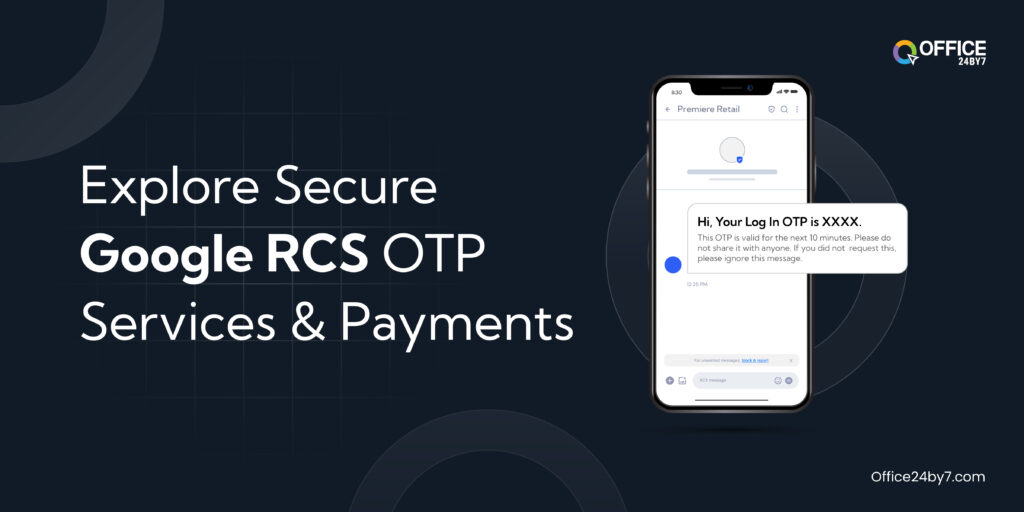
Not sure if this blog on Google RCS OTP contains quality information?
Try our 1-minute short audio summary to decide. 🎧
Rich Communication Service (RCS) has been around since 2007/08 as GSMA’s chosen protocol to replace SMS. Initially, it was met with hesitation due to its software requirements and network upgrades. But after so many years, Google RCS is now coming back to the limelight. This evolving landscape promises enhanced communication capabilities beyond traditional text messaging.
Google RCS OTP boasts numerous improvements over SMS. But today we will explore Google RCS’s role in the realm of security and payments in depth. We’ll also uncover how it might reshape the way we verify identities and send online interactions.
Authentication methods for online services have evolved significantly over time. What began as simple username and password combinations has grown into more robust two-factor authentication (2FA) systems. Today, one-time passwords (OTP) are the most common form of 2FA, adding an extra layer of security to user accounts.
This blog discusses how Google RCS OTP features can achieve Strong Customer Authentication (SCA), potentially replacing OTP-over-SMS, particularly in online payment applications, how it can enhance existing payment methods, and the possibility of integrating payments directly into RCS, offering a seamless user experience.
Difference Between SMS and Google RCS
| Traditional SMS | Google RCS | |
| User Experience | • Intuitive to use and there is no need for user training • Instantaneous access • Feature poor • Limited message size | • Can be intuitive to use, similar to SMS • Instantaneous access • Feature rich • Message size much larger than SMS (up to 20 kilobytes) |
| Availability | • Ubiquitous • Delivery cannot be guaranteed • Access over legacy technologies | • Becoming ubiquitous, needs support from MNOs, Platforms and OEMs • Provides delivery and read notifications • Access over various bearers |
| Security | • Known vulnerabilities • Relies on implicit network authentication • Class 2 SMSs are encrypted | • Various authentication and security methods supported • No end-to-end encryption, however, hop-to-hop encryption is used to support lawful interception • Verified Sender |
| Dependencies | • Works without data connection • App installation is not needed | • Becoming ubiquitous, needs support from MNOs, Platforms, and OEMs • Provides delivery and read notifications • Access over various bearers |
What is OTP?
OTP (One-Time Password) is a security feature used for verifying the identities of users. These become important to secure logins, sign-ups, and transaction processes where there is involvement of confidential data. The process of OTP authentication involves sending a unique code which is either numeric, a string of characters, or alphanumeric to the user’s registered mobile device. This password is then required by the user to enter correctly to complete the verification process.
At present OTP authentication widely relies on traditional SMS which is called OTP over SMS despite its weaknesses. Some other alternatives for OTP authentication are Google RCS OTP, OTP over Voice Calls, OTP over Push Notifications, and OTP generated from the software.
What Are The Benefits of Google RCS OTP Services?
Google RCS offers an improved user experience and additional features compared to SMS. European, US and Asian operators are already using Google RCS OTP for enhanced customer engagement in business messaging campaigns. Google is actively promoting RCS, even launching it directly in markets like the UK, France, and Spain.
Google RCS OTP adoption is growing rapidly, though its market penetration varies by region due to Apple’s current lack of support. Meanwhile, the EU’s Second Payment Services Directive (PSD2) mandates Strong Customer Authentication (SCA) for electronic payments. While OTP-over-SMS is permitted, a better solution is needed, and Google RCS OTP appears to be a promising candidate.
Integrating OTP functionality with Google RCS messaging can enhance the security and user experience of authentication processes. By sending Google RCS OTP messages, businesses can leverage its interactive features in a more engaging and user-friendly manner. This can help improve the conversion rates of authentication processes and reduce the risk of fraud.
📗 You May Also Like Upgrade Your Messaging Services With Google RCS for Businesses
Why Choose Google RCS OTP?
Google RCS OTP offers several advantages over traditional SMS-based OTP solutions:
Customer Engagement
Businesses can now provide visually appealing and interactive OTP experiences for users, increasing engagement and trust.
Authenticate Registrations
Businesses can confirm the legitimacy of new users during service registration with OTP authentication messages sent immediately to their desired mobile numbers.
Password Resets
When a customer initiates a password reset request, businesses can send an OTP to their registered mobile number to confirm their authenticity. The ability to use a verified and branded sender increases trust and reduces the chances of your customers becoming victims of fraud.
Real-time Transaction Confirmation
Using Google RCS OTP for real-time transaction confirmations increases security for your customers and business without adding friction to the process.
User Reactivation
When a user logs into their account following a prolonged period of inactivity, verify their identity with a Google RCS OTP to stop possible hacking attempts.
Weaknesses of OTP Authentication-Over-SMS
Fraudulent SIM Replacement: This attack is also known as SIM-Swap or SIM-Jacking. The victim’s mobile subscription is taken over by using unauthorized number porting or ordering a replacement SIM.
SMS Re-routing: Attackers can exploit vulnerabilities in SS7 and potentially re-route and access SMS messages containing OTPs which can be used to complete a payment transaction.
Malware: Fraudsters can exploit malware installed on a victim’s mobile phone and retrieve OTPs from SMSs to complete a payment transaction.
Phishing: Fraudsters can come in between the victim and a legitimate service provider. The victim may be redirected to a fake website via a phishing message, and the fraudster can readily capture basic authentication information from the victim. The victim may also be convinced unwittingly to supply OTP information.
Lack of Confidentiality: SMSs are stored as plaintext in the Short Message Service Centre (SMSC) before delivery to the recipient. Any security compromise of the mobile network including the SMSC due to malware or insider attacks can lead to potential disclosure of OTPs in SMSs.
Delayed Delivery: An SMS containing an OTP may not be delivered promptly due to network congestion where the number of users is unusually high.
Delayed Presentation to Consumer: If your phone memory is low the SMS with OTP may not be available promptly.
🏆 Also Read More About A Case Study on Google RCS for Small Businesses in India
How Google RCS OTP Revolutionize Payment Security and UE
Enhanced Security in the PSD2 Era
Google RCS OTP offers significant potential for improving payment experiences across various use cases, particularly in the context of PSD2 and SCA. Two key aspects of Google RCS OTP stand out: improved security and enhanced customer experience. Banks and regulators, while concerned about SMS security flaws, have recognized that OTP-over-SMS benefits outweigh its drawbacks.
SIM swap attacks, though painful for individuals, are socially engineered one device at a time. This represents a vast improvement over wide-scale attacks using stolen card databases with no inherent authentication. As criminals shift to targeting known weaknesses like SIM swaps or phishing, Google RCS OTP’s Sender Verification and improved security become invaluable for banks and regulators.
Elevating Customer Experience
Google RCS OTP allows banks to extend enriched payment offerings to customers who may not use banking apps. It provides up-to-date information about previous transactions, current balances, and payment status. Crucially, RCS enables the creation of frictionless authentication journeys across various payment scenarios in conversational commerce.
Effectively applied, Google RCS OTP-based authentication has the potential to displace other methods, except perhaps for x-Pays in some markets. The consumer experience will significantly improve with RCS, as existing OTP-over-SMS processes are poorly tolerated due to a lack of better alternatives.
The Future of Authentication
Replacing OTP-over-SMS with Google RCS OTP would significantly reduce phishing risks. When combined with frictionless authentication factors like behavioral biometrics, real-time biometric information transmission, Verified Sender, and enriched customer data, Google RCS OTP offers a vast improvement over current market solutions.
Banks have recognized mobile devices as the preferred method for performing SCA under PSD2. Google RCS OTP will enhance customer experience, reduce fraud risks, and improve the adoption of mobile-based authentication methods. This creates a win-win situation for both banks and consumers.
Google RCS OTP FAQs
How does Google RCS OTP handle device compatibility, and will this affect its deployment?
Google RCS OTP addresses device compatibility through the GSMA Universal Profile, which aims to standardize RCS deployments globally. Most device manufacturers and platforms support native RCS clients, except Apple. However, service providers can overcome this limitation by offering downloadable apps.
Can poor mobile data coverage be a problem for using Google RCS OTP?
Yes, poor mobile data coverage can be a problem. If the customer doesn’t have good mobile data or Wi-Fi, RBM might not work. This means they won’t receive your messages.
What can banks do if someone has poor mobile coverage?
Banks can use special RBM tools to help people with poor coverage. For example, they can send messages later when you have better coverage or ask you to confirm your identity again if the message is old.
What are the possible methods for payment integration using Google RCS OTP?
Under Google RCS OTP, in the context of conversational commerce, there are a range of possible methods for payment integration:
- You can use a dedicated authentication/payment chatbot
- You can use a 3rd – party or MNO application
- You can access a payment method via a web browser
- You can access a payment method via a web view
- You can use an x-Pay payment capability
How does the cost of Google RCS compare to traditional SMS?
While traditional SMS might be cheaper per message, Google RCS OTP often offers better value due to higher engagement rates and richer features.
Are there any hidden costs associated with RCS implementation?
While there aren’t typically hidden costs, it’s essential to consider integration costs with existing systems. Additional expenses might arise from developing custom RCS templates or features. Understanding these potential costs upfront is crucial for accurate budgeting.
Is there a specific platform or software required to use RCS?
Before you can send messages to users, you need to register as a partner with RCS Business Messaging (RBM). As a partner, you can create agents for brands that you manage and send messages through those agents. Once done you can complete the verification, set up your partner account, and create your Agent profile.
What is the level of technical expertise needed to implement Google RCS OTP?
The level of technical expertise required depends on the complexity of Google RCS OTP implementation. Basic integration might not demand extensive technical knowledge, but developing custom features or deep integrations would necessitate more specialized skills.
What security measures are in place to protect customer data transmitted via Google RCS OTP?
RCS OTP incorporates robust security measures to protect customer data. It uses end-to-end encryption (E2EE) ensuring that messages are readable only by the communicating parties.





